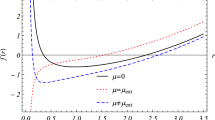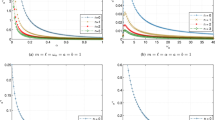Abstract
The central idea of this paper is that forming the black hole horizon is attended with the transition from the classical regime of evolution to the quantum one. We offer and justify the following criterion for discriminating between the classical and the quantum: creations and annihilations of particle-antiparticle pairs are impossible in the classical reality but possible in the quantum reality. In flat spacetime, we can switch from the classical picture of field propagation to the quantum picture by changing the overall sign of the spacetime signature. To describe a self-gravitating object at the final stage of its classical evolution, we propose to use the Foldy–Wouthuysen representation of the Dirac equation in curved spacetimes, and the Gozzi classical path integral. In both approaches, maintaining the dynamics in the classical regime is controlled by supersymmetry.
Similar content being viewed by others
References
Misner, C.W., Thorne, K.S., Wheeler, J.A.: Gravitation. Freeman, San Francisco (1973)
Chandrasekhar, S.: The Mathematical Theory of Black Holes. Oxford University Press, New York (1992)
Heusler, M.: Black Hole Uniqueness theorems. Cambridge University Press, Cambridge (1996)
Chruściel, P.T.: Black Holes. Lecture Notes in Physics, vol. 604, p. 61. Springer, Berlin (2002). arxivurl:gr-qc/0201053
Carlip, S.: Black hole entropy from conformal field theory in any dimensions. Phys. Rev. Lett. 64, 435 (1976). arxivurl:hep-th/9812013
Solodukhin, S.: Conformal description of horizon’s states. Phys. Lett. B 454, 213 (1999). arxivurl:hep-th/9812056
Wilson, K.G.: Problems in physics with many scales of length. Sci. Am. 241, 158 (1979)
Wilson, K.G.: The renormalization group and critical phenomena. Rev. Mod. Phys. 55, 583 (1983)
Chapline, G., Hohfeld, E., Laughlin, R.B., Santiago, D.I.: Quantum phase transitions and breakdown of classical general relativity. Int. J. Mod. Phys. 18, 3587 (2003). arxivurl:gr-qc/0012094
Laughlin, R.B.: Emergent relativity. Int. J. Mod. Phys. 18, 831 (2003). arxivurl:gr-qc/0302028
Hawking, S.: Black hole explosions? Nature 248, 30 (1974)
Hawking, S.: Quantum particle creation by black hole. Commun. Math. Phys. 43, 199 (1975)
Hawking, S., Ellis, G.: The Large Structure of Space-Time. Cambridge University Press, Cambridge (1973)
Horowitz, G.T., Maldacena, J.: The black hole final state. J. High Energy Phys. 02, 008 (2004)
Brink, L., Deser, S., Zumino, B., Di Vecchia, P., Howe, P.: Local supersymmetry for spinning particles. Phys. Lett. B 64, 435 (1976)
Feynman, R.: The development of the space-time view of quantum electrodynamics. Phys. Today 19, 31 (1966)
Kosyakov, B.: Introduction to the Classical Theory of Particles and Fields. Springer, Berlin (2007)
Foldy, L.L., Wouthuysen, S.A.: On the Dirac theory of spin- \(\frac{1}{2}\) particles and its nonrelativistic limit. Phys. Rev. 78, 29 (1950)
Case, K.M.: Some generalizations of the Foldy–Wouthuysen transformation. Phys. Rev. 95, 1323 (1954)
de Vries, E.: Foldy–Wouthuysen transformations and related problems. Fortschr. Phys. 18, 149 (1970)
Thaller, B.: The Dirac Equation. Berlin, Springer (1992)
Obukhov, Yu.N.: Spin, gravity, and inertia. Phys. Rev. Lett. 86, 192 (2001). arxivurl:gr-qc/0012102
Romero, R.P.M., Moreno, M., Zentella, A.: Supersymmetric properties and stability of the Dirac sea. Phys. Rev. D 43, 2036 (1991)
Heidenreich, S., Chrobok, T., Borzeszkowski, H.-H. v.: Supersymmetry, exact Foldy–Wouthuysen transformation, and gravity. Phys. Rev. D 73, 044026 (2006)
Galvao, C.A.P., Teitelboim, C.: Classical supersymmetric particles. J. Math. Phys. 21, 1863 (1980)
Gozzi, E.: Hidden BRS invariance in classical mechanics. Phys. Lett. 201, 525 (1988)
Gozzi, E., Reuter, M., Thacker, W.D.: Hidden BRS invariance in classical mechanics, II. Phys. Rev. D 40, 3363 (1989)
Abrikosov, A.A. Jr., Gozzi, E., Mauro, D.: Geometric dequantization. Ann. Phys. (N.Y.) 317, 24 (2005). arxivurl:quant-ph/0406028
Jackiw, R., Nair, V.P., Pi, S.-Y., Polychronakos, A.P.: Perfect fluid theory and its extension. J. Phys. A 37, R327 (2004). arxivurl:hep-ph/0407101
Robinson, S., Wilczek, F.: Relation between Hawking radiation and gravitational anomalies. Phys. Rev. Lett. 95, 011303 (2005). arxivurl:gr-qc/0502074v3
Gozzi, E., Mauro, D., Silvestri, A.: Chiral anomalies via classical and quantum functional methods. Int. J. Mod. Phys. A 20, 5009 (2005). arxivurl:hep-th/0410129
Author information
Authors and Affiliations
Corresponding author
Rights and permissions
About this article
Cite this article
Kosyakov, B.P. Black Holes: Interfacing the Classical and the Quantum. Found Phys 38, 678–694 (2008). https://doi.org/10.1007/s10701-008-9227-z
Received:
Accepted:
Published:
Issue Date:
DOI: https://doi.org/10.1007/s10701-008-9227-z




